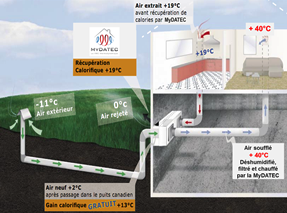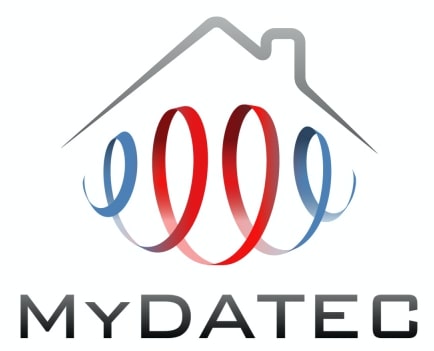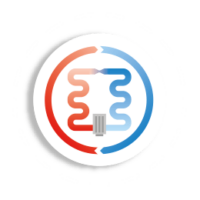Indoor air pollution is the main concern of the MyDATEC teams in order to manufacture products that combine the best of indoor air quality and energy savings via energy recovery from extracted air(thermodynamic ventilation). We believe that over time, air change rates will need to increase in residential homes.
Based on an article from the ECOBAT blog: How to combine ventilation and modulation? Jean-Philippe Pié
“In thirty years, inside homes, lifestyles have changed significantly. For example, housing density has increased, the way and rate of hot water use is different.”

Operation of Mydatec with a Canadian air well.
However, in the residential sector, the regulations have not changed – unlike in the tertiary sector and in establishments open to the public. And while five thermal regulations have succeeded each other in three decades, the quality of indoor air in homes is still standardized by the decree of March 24, 1982. Obsolete today. Its main flaw? According to Christian Cardonnel, president of the thermal engineering firm Cardonnel Ingénierie, “The air flow rates, humidity levels and pollution standards set out in this decree no longer correspond to real needs. An illustration: in the bathrooms, the shower has replaced the bath and generates much more water vapor.”
Vieillot, this decree is also incomplete, especially in the control of indoor air quality (CO2, VOC, fine particles,…), the only measurement of humidity is not sufficient. However, in living rooms, such as the living room, CO2 concentrations can reach peaks of up to 6,000 ppm during a family meal… compared to just under 400 ppm in the atmosphere. In a bedroom, a level of 1500 ppm is easily exceeded.
The first solution recommended by Christian Cardonnel is obvious: maintain the air renewal circuits which, over time – one million cubic meters of air enter and leave a house in a year – degrade, become clogged and become counter-productive. The second one? Modulate flow rates according to usage. […]
Some systems are able to take into account the weather conditions or the density of pollutants outside. Thus, in mid-season, the air renewal rate can be increased to take advantage of a comfortable outdoor temperature. Conversely, in the event of a pollution peak, this rate may drop sharply for a few hours.” […]
With a thermodynamic CMV, in mid-season, not only can you ventilate at will, but ventilating also brings you the 2 to 3 kw of heating necessary for the complete heating (most of the time depending on the building) of the house. Of course these 2 to 3kw have “cost” you 0.5 to 0.8Kw electric, that is to say about 4 times less. The
MyDATEC thermodynamic ventilation system
runs at the nominal flow rate V2 or High Speed (about 200m3/h)
In winter, this principle of modulation according to the real needs can and must be articulated with the energy saving strategies – it is particularly true in the framework of a double flow ventilation system – which supposes an arbitration between the temperatures, the hygrometries, the CO2 rates. This arbitration can also be automated, via dedicated software. In the summer, comfort standards take over, by favoring nighttime air renewal. As we can see, this modulation implies taking into account multiple variants. Not so simple… Especially since the characteristics of the building must be taken into account, as an old building and a new house are not ventilated in the same way.” […]
The MyDATEC thermodynamic CMV integrates the notion of free-cooling or night-time over-ventilation (depending on the model and range evolution), mechanically, and soon automatically according to outdoor temperature scenarios (new range soon to be marketed). In the same way that your installation of thermodynamic VMC is able by simple inversion of cycle of the thermodynamic system, to produce 1.7 to 2kW of refrigerating power (in option), ideal for the summer comfort of the houses which have tendency to overheat…




